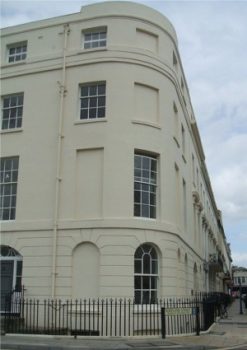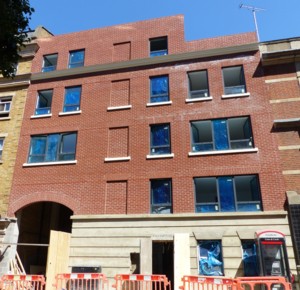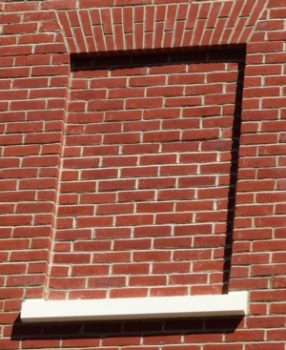If you type “window tax” into google, and click on “images”, you get images like this one:
That being the first image that wikipedia shows you, in their entry on the Window tax.
Says wikipedia about this tax:
The window tax was a property tax based on the number of windows in a house. It was a significant social, cultural, and architectural force in England, France, Ireland and Scotland during the 18th and 19th centuries. To avoid the tax some houses from the period can be seen to have bricked-up window-spaces (ready to be glazed or reglazed at a later date). In England and Wales it was introduced in 1696 and was repealed in 1851,
London, and presumably all the other cities of Britain, still contain many such bricked-up windows, that date from this time.
But yesterday, I saw a new block of flats, still in the process of being constructed, just a few dozen yards from my own front door.
The front of which looks like this:
Let me be clear. There is a vertical row of bricked-up windows there, in between the real windows. And you can clearly see that this is a brand new building, not even yet occupied.
Here is a close-up shot of an individual bricked-up window:
I have long known the bare outlines of this window tax story, as I guess most of my fellow Brits do also, especially if they live in towns or cities. Windows were taxed, so people filled the windows in, to avoid paying the tax.
So, my first – outraged and spasmodic – reaction to this new building, when I saw these non-windows was: My God, have they brought back the window tax?
But, on further reflection, I further guess that this is isn’t the first time that recent property developers have created bricked-up windows, or what look like bricked-up windows, to create, pretty cheaply, the suggestion of antiquity in an otherwise blandly modern building.
When I see other bricked-up windows, I will no longer assume that they date from the time of the window tax. Maybe they merely allude to this time.
But, am I missing something? Is there a more practical purpose to such non-windows? Is it helpful to create windows that can later be un-bricked-up (bricked-down?), at some future date? Does it help to think about maybe wanting a window that you don’t want now, beforehand, just in case?
Is this a mere part of the construction process. Will these bricked-up windows all turn into real windows very soon, before anyone even moves in?
Or are there quite different reasons for making a new bricked-up window, which I am unaware of? Perhaps so. In fact, probably so. And if so, I hope that commenters will perhaps enlighten me.







Well, a month ago I would have suggested Apocalyptic Climate Change as the driving force, but now of course, the answer is obvious. Brexit!
Sure,it a warning to “gub’mint” concerning… defenestration!
There was also the candle tax, which brought about the chandelier. And the newspaper page tax, which bought about the broadsheet. And the car tax in the US, which brought about the SUV…
Brick is so beautiful 🙂
Perhaps they plan to stick something in there? I saw cutouts like that in the walls of an ancient Greek theatre once – apparently they stuck stone slabs showing religious icons in them.
Kevin B wins the thread. 🙂
IMO it’s an architectural conceit, and possibly to help pass zoning requirements: often new buildings are required to visually fit the neighborhood, which incentivizes such retro styling.
Forgot to say: I’ve read that that the windowless rooms of the poor in Dickens’ novels were the result of this tax, and thus the result of government policy and not heartless capitalism.
Maybe bricks are cheaper at the moment than glass?
I am ashamed, deeply and bitterly ashamed, of my beloved Mother Country. Couldn’t you feisty British guys find something suitable hefty, perhaps a wrecking ball, to shove through those eyesores? Maybe they could then be filled in with something more attractive, as well as useful. Like … glass?
If begging and pleading do not motivate you to revise your architecture, here’s an offer you can’t refuse. Fix the g- d- things or I will start shipping over boatloads of our modern “churches.” They come in two styles: barns with wooden silos on the roof-ridge, painted brick-red; and yellowed-concrete affairs that look like failed prototypes for a warehouse.
“suitably” .
Let’s not forget the door knob tax, which caused the regressive century-move back to latches, and the window screen tax, because apparently anti-bug mesh is a “luxury” that begs taxation, and the closet tax which still encourages the use of wardrobe furniture.
But the most FUCKING insane is the TV tax, and you have a low-brow moron driving around in a van searching for homes using the “telly” without a government license, which they demand from you after banging on your door like a nazi demanding to see a Jew’s papers.
Sorry my brit friends, but your nations is so soviet union and you don’t even freakin realize it. It boggles the mind.
Bricked over windows in a vertical line?
I would suspect an elevator shaft on the other side.
My guess is that the window outlines were added to create symmetry, and all the windows are in columns 2 windows wide. They lack of glass is likely due to a lift (an elevator on this side of the Atlantic). Or perhaps they didn’t want windows in a staircase.
Nothing so sinister as “design.”
Note to self. Don’t post comments at midnight. “as all the windows are in columns of 2” “The lack of glass…”
Generally, this is the result of either a late design change that imposes an altered interior plan on an already-begun exterior such that an interior structure (like a wall or a utility stack) makes the designed window impossible, or a heat-loss calculation error that leaves a design ratio that exceeds the local code-mandated wall-to-glass ratio limit.
I believe the technical architectural term for such a feature is “oh, sh*t!”
I’ve seen elevator shafts and fire escapes backing onto that wall section.
I am with Zendo Deb and Bod about the lift shaft, but also with PapayaSF about matching the neighbourhood. I note, for instance, that the heavy brown cornice is continuous with that of the adjoining building. Any other points of similarity or symmetry? IMO this would be a legitimate if playful design consideration.
In Scotland, the equivalent tax was a “roof tax”. It was obvious to the Scottish government that merely demanding money for the right to light would never raise a penny. Demanding money for the right not to be rained on was the only way.
This is partly why there are statistically more and better preserved houses in England than in Scotland. When an English noble family realised they had overspent on bribery to secure the borough election, and went to the continent for a decade to recoup finances, they bricked up all the windows, preserving the house; some original Elizabethan houses survived the period of Georgian modernisation in this way. In a similar situation in Scotland, you removed the roof – which was not so conducive to preserving the interior.
I am totally with Thailover on the TV Licence. It is an utterly absurd anachronism. The question is, what would sane people have to do to get rid of it? There seem to be so few of us.
Replying to Stonyground (July 21, 2016 at 9:25 am), I suggest an easy initial transition would be to convert the license from a tax to a compulsory voucher that purchasers then used to buy beeb programmes on a pay-to-view basis, thus transferring budget control from beeb bigwigs to beeb viewers. From a political point of view, in the UK as it is today, I think this would be doable for a government with the guts to try (one may wish) where mere immediate abolition might be a harder sell.
Broadening to allow non-beeb=-related programmes also to be purchased with voucher funds (i.e. instead of their needing to find advertisers), would be a second step. Voluntary top-up could then be allowed over some minimum which could be reduced. Thus compulsion might be relaxed, one day even dropped. One may dream.
Using fake bricked-up windows as a means to break up an expanse of wall are nothing new. My house in Ayrshire was built in the 1850s. Spot the fake window. The builder could have put in a real window, but there is only a cupboard in that location.
I reckon the lift shaft is behind that row of non-windows, and the architect screwed up.
“Never assign to malice, that which is adequately explained by incompetence”
Hmmm. Positioned to side of door. Top floor has only one window to right of fake windows, above the entrance, so (not being in Japan) too small a space for an appartment, so suggesting the right of the fake windows is the space occupied by landing/stairs.
So this seems to be a pretty good guess for a lift or stairwell – by the entrance and connected to a series of landings (the single windows). If it is the lift, then I suspect there are very good reasons for not having windows onto the shaft around safety and appearance.
Purpose-built high rises are typically built around the elevator banks – often, the structural integrity of the building is reliant on the risers and (in the case of a large footprint building such as a New York office building) having the elevator banks in the middle doesn’t compromise valued characteristics such as open office spaces, as well as making the entrance to an office optimally positioned for access to all parts of an office.
Smaller buildings and retrofits (certainly in New York) are often located against an exterior wall, because they tend to be the best pre-existing load-bearing structure. A smaller elevator will *often* have the winch and machinery at the top of the shaft, rather than at the bottom so that floorspace can be conserved (because in the case of NYC, excavating a winch room in a basement in hard rock is costly. So, you put the winches and pulleys at the top. The problem then is that you have to support that weight – hence a load-bearing wall. And in a smaller or older building – the outside walls are typically the only pre-existing choice you have.
The same will be true for fire escapes. I seem to remember that NYC building codes require indoor evacuation routes in office buildings, and the last place I’d want to be was in a fire escape in the middle of a building with no ability to gain instant egress close to street level (this isn’t the case with modern high-rises – the escape routes are typically part of the core structure along with the elevator shafts, with separate (diverse) exits thru’ loading bay and direct onto the street.
Have they brought back the window tax?!?!
They will soon
This is a recent build over the road from me. The fake windows are simply to break up the blank walls; no lift shaft on the other side.
Poundbury is the reason for such things. It triggered a deluge of poor copycat housing estates and I would suggest that the architect who designed this building was influenced by such designs.
As others have said there could one or more of several reasons.
I lean towards the ‘breakup ( visually ) of a large flat blank expanse.
Also, windows are expensive, breakable, and have to be ( or at least should be ) cleaned on a regular basis – brick, not so much.
In addition to windows being expensive etc. we MUST mention
( wait for it ) global warming, um, er ,ah, ta da climate change !!
Windows ( except for some outrageously priced ones ) are incredible heat leaks and the leaks operate year round and in both direction ( outside to inside or inside to outside ), depending, of course, on the season.
Just a couple of thoughts.
Can one be assured that Microsoft is not involved?
Cheers
I wonder how many people died because of fires caused by lanterns or candles in rooms with bricked up windows.
In Edinburgh’s New Town, there are numerous examples of fake windows. As the bulk of the area was built during Scottish Window Tax times, some fake windows may well be the result of tax avoidance, whereas others are designed to balance symmetrical facades.
But here’s an example in Broughton Street, which looks very similar to Brian’s modern example. The position of the main entrance would suggest that the internal stairwell is probably behind the column of fake windows. There’s another like it a few doors down the street.
Jerry @ 7pm
Interesting comment, especially these days when it seems to be the fashion to have house extensions made with vast expanse of glass. My sister lives in a 13th century thatched roof house with small windows – beautifully warm in winter and cool in summer.
My other concern re the article is that it took over 150 years to repeal such a bad tax. That doesn’t bode well for any type of tax reform.